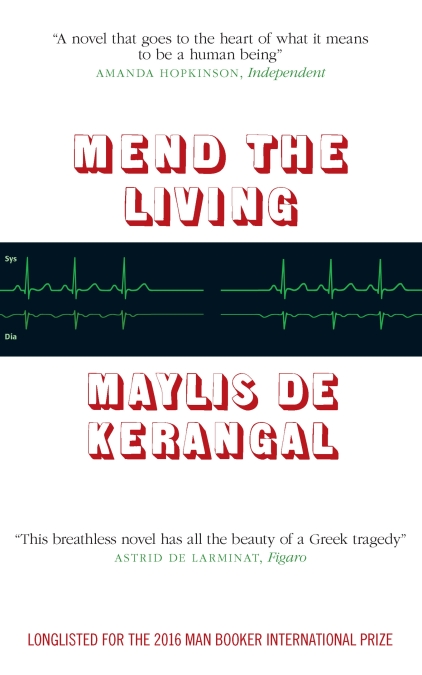
The French writer Maylis de Kerengal proposes a poetic and detailed novel about the challenging drama that surrounds the unexpected death of a child and the dilemma that parents face when it comes to donating that child’s organs. Mend the Living is a work of extraordinary richness that invites us to reflect on the conception of life and death, survival and hope. It is worth noting that it has a splendid prose that intertwines poetry and science.
Mend the Living takes place over a twenty-four hour period in which the migration of a heart takes place. The book begins one frosty morning, with three good friends out surfing and enjoying their physical plenitude to the fullest. Everything is precipitated when they are involved in a terrible car accident on their way home. Of the passengers, those wearing seat belts end up with minor injuries. However, Simon Limbeau, unprotected, goes through the windshield of the van and suffers overwhelming injuries to his brain.
Despite the efforts of doctors and specialists, Simon Limbeau’s consciousness, sensitivity, mobility and vegetative functions are irrevocably extinguished. Sadly, the clinical verdict is devastating: the young surfer is brain dead. There is nothing science can do to bring him back.
In the first part of the book, the shocked parents must face a brutal decision: whether or not to allow the donation of their firstborn’s organs. As expected, Marianne and Sean are reluctant to accept the painful reality. In the midst of their deep grief, they question organ donation and are especially opposed to giving Simon’s heart away. The fact is that Marianne and Sean believe that their son’s heart should remain with him because it has always been the receptacle of his hopes, illusions, fears and joys.
Mend the Living contains important reflections on what the human heart really is. The French writer deliberates with immense depth about its physical and spiritual nature. On the one hand, the book describes the heart as an organ, as a kind of pump that circulates up to 5 liters of blood per minute and keeps the organism active. On the other hand, the book deals with the spiritual and subjective dimensions of the heart. The author contemplates it as the cradle of love, affection, emotions and heroism.
In the story, Simon’s parents do not want anyone to touch his heart, “because the heart is more than the heart.”
In the midst of this delicate situation, the writer Maylis de Kerengal presents a beautiful cascade of characters. From the moment Simon is transferred to Intensive Care, a human chain is woven through which the process of organ harvesting and transplantation can be completed. In this regard, the novel mainly shows the relationship between the family nucleus and the clinical nucleus.
About Simon’s family, we meet his parents and his younger sister, Lou. It is clear from the outset that this is a typically imperfect but close family. Although Marianne and Sean are divorced, they try to do their best for their children. As is to be expected, tragedy leads them into the abyss. The parents support each other in coping with grief, mourning, and the guilty feeling that they should have been more protective of their son.
Once at the hospital, the reader meets the staff working with Simon and around the donation. As the novel progresses, a series of stories intermingle.
In this way, we see the work of characters such as Pierre Révol, the chief physician, who takes over the case and declares the young man brain dead; Thomas Rémige, the coordinator of Organ and Tissue Harvesting, responsible for broaching the subject of donation with the family and obtaining consent; Cordelia Owl, an attentive nurse dealing with intense romantic difficulties. The extraction and transplant team is also known, and there are traces of the organ recipients. Although it is a choral story, it is very easy to connect with the characters because each one has a clear identity and a peculiar nature.
Exactly twenty-four hours after Simon’s accident, the young man’s liver, lungs, kidneys and heart give life to a series of people in precarious health situations. Thus, Marianne and Sean’s tragedy means the rebirth of other families besieged by chronic or terminal illnesses. Chekhov’s emblematic sentence “Bury the dead and mend the living” is quoted in the book and it can be said that the whole plot revolves around it.
It is important to note that this novel does not focus on how young Simon Limbeau lived, nor does it focus on how he died. Instead, Mend the Living is a necessary and beautiful book that raises a deeper understanding about the importance of organ and tissue donation.
Readers will be struck by the French novelist’s meticulous explanations of hospital situations. In this regard, the author narrates step by step, in a raw and frontal manner, how healthcare personnel face complex ethical, clinical and logistical issues regarding organ consent, removal and transplantation. Mend the Living not only provides a wealth of detail to appeal to the non-specialist public but can also serve as an example to those interested in the medical profession.
This novel was first published in France under the title Réparer les vivants, and subsequently had two English translations. In the United States, it was titled The Heart and was adapted by Sam Taylor. In the United Kingdom, it was published as Mend the Living and was translated by Jessica Moore.
Among the most prestigious awards this book has received are: Charles Brisset Literary Award, Grand Prix RTL-Lire, Orange Book Award, Lire Magazine Best French Novel Prize, L’Express – BFMTV Reader’s Prize, Relay Prize for Travelers, Wellcome Book Prize. Undoubtedly, Maylis of Kerengal has managed to make a remarkable contribution to both the medical and literary fields.
Image credit: NappyStock

